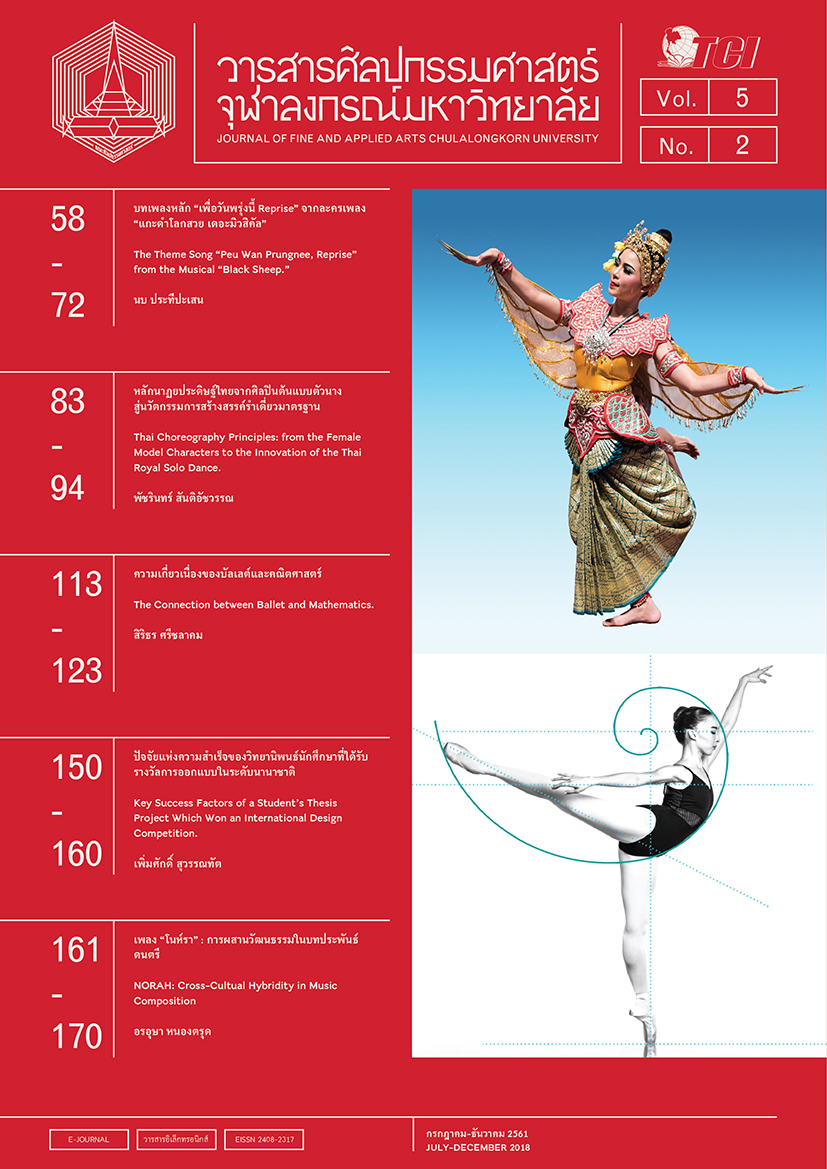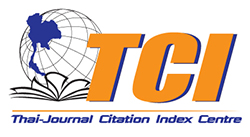ความเกี่ยวเนื่องของบัลเลต์และคณิตศาสตร์
Keywords:
บัลเลต์, คณิตศาสตร์, ท่าพื้นฐานของแขนและเท้าในบัลเลต์คลาสสิก, ballet, mathematics, geometric, Basic Positions of Arms and Feet in classical balletAbstract
บทคัดย่อ
บทความวิจัยฉบับนี้มาจากงานวิจัยเรื่อง “ความเกี่ยวเนื่องของบัลเลต์และคณิตศาสตร์” ในโครงการวิจัยการศึกษาความเกี่ยวเนี่องของนาฏยศิลป์ตะวันตกและคณิตศาสตร์ ตามแผนยุทธศาสตร์คณะศิลปกรรมศาสตร์ จุฬาลงกรณ์มหาวิทยาลัย ประจำปีงบประมาณ 2559 บทความวิจัยฉบับนี้มาจากงานวิจัยเรื่อง “ความเกี่ยวเนื่องของบัลเลต์และคณิตศาสตร์” ในโครงการวิจัยการศึกษาความเกี่ยวเนี่องของนาฏยศิลป์ตะวันตกและคณิตศาสตร์ ตามแผนยุทธศาสตร์คณะศิลปกรรมศาสตร์ จุฬาลงกรณ์มหาวิทยาลัย ประจำปีงบประมาณ 2559 มีวัตถุประสงค์เพื่อให้เป็นแหล่งค้นคว้าข้อมูลที่เกี่ยวข้องกับทฤษฎีบัลเลต์ และเป็นตัวอย่างการศึกษาวิจัยทฤษฎีบัลเลต์ที่สัมพันธ์กับศาสตร์แขนงอื่น อีกทั้งเป็นประโยชน์ต่อการเรียน การสอนและการศึกษานาฏยศิลป์ตะวันตกในประเทศไทยต่อไป วิธีดำเนินงานวิจัยในงานวิจัยฉบับนี้ ได้แก่ การศึกษาข้อมูลเอกสาร การสัมภาษณ์ผู้เชี่ยวชาญ การสังเกตการณ์การเรียนการสอนเกี่ยวกับพฤติกรรมและแนวคิดการนำเส้น(Line) และรูปทรง (Form) ของคณิตศาสตร์มาใช้ในการสอนของครูผู้สอนบัลเลต์ในระดับนานาชาติ และจากประสบการณ์ในการเรียนและการสอนบัลเลต์ของผู้วิจัยเอง เพื่อวิเคราะห์ความเกี่ยวข้องของแนวคิดทางด้านคณิตศาสตร์ที่แฝงอยู่ในพื้นฐานของบัลเลต์ และท่าแขนและเท้าพื้นฐานของบัลเลต์ทั้ง 5 ท่า แล้วนำข้อมูลมาเรียบเรียง วิเคราะห์ สรุปเป็นงานวิจัยฉบับนี้ ผลจากการวิจัยพบว่า ความเกี่ยวเนื่องของบัลเลต์และคณิตศาสตร์ปรากฏในแนวคิดของระบบจำนวน ได้แก่ การใช้ตัวเลขเป็นชื่อเรียกท่า และการกำหนดชื่อท่าหรือชื่อลักษณะการเต้นโดยเรียกตามจำนวน ในแนวความคิดรูปทรงเรขาคณิต ปรากฏเส้นและรูปทรงที่เป็นค่านิยมความงามแบบบัลเลต์คลาสสิก ปรากฏแนวคิดสัดส่วน ว่าด้วยสัดส่วนในอุดมคติของร่างกายนักบัลเลต์ การเปิดออกของขาและเท้า การกำหนดตำแหน่งของขาเป็นองศา มุมและทิศทางใน การจัดวางร่างกาย และยังปรากฏแนวคิดสมมาตรในบัลเลต์คลาสสิกอีกด้วย ทั้งในงานวิจัยฉบับนี้ได้วิเคราะห์แนวคิดคณิตศาสตร์กับท่าพื้นฐานของแขนและเท้าในบัลเลต์คลาสสิกทั้ง 5 ท่า โดยการทำภาพแบบจำลอง ทำให้เห็นว่าแนวคิดทางด้านคณิตศาสตร์เป็นมุมมองที่สะท้อนให้เห็นค่านิยมของความงามในบัลเลต์ การเข้าใจมุมมองเหล่านี้จะทำให้สามารถเต้นบัลเลต์ได้อย่างสมบูรณ์มากยิ่งขึ้น
Abstract
This research has been studied about the connection between western dance and mathematics according to the strategic plan of Faculty of Fine and Applied Arts, Chulalongkorn University in the fiscal year 2016, The objectives of this study are to be the resource about the ballet theory and to deploy the case study between ballet techniques and other related theories. As well as this, the study aims to contribute the western dancing education in Thailand. This research has been studied about the connection between western dance and mathematics according to the strategic plan of Faculty of Fine and Applied Arts, Chulalongkorn University in the fiscal year 2016, The objectives of this study are to be the resource about the ballet theory and to deploy the case study between ballet techniques and other related theories. As well as this, the study aims to contribute the western dancing education in Thailand. The data of this study has been collected through literary research, interview with the experts, class behavioral observation and the application of lines and forms based on mathematics theory to the class by the ballet teachers in an international level, along with the teaching experience of own researcher. From this data, the connection between ballet and ideas of mathematics theory, which has been infiltrated in the basic of ballet techniques and 5 Basic Positions of Arms and Feet, will be analyzed. It is found that the connection between ballet techniques and mathematics theory is appeared in the form of numeric system. For example, the common ballet terms have been named after the number in mathematics system. Based on the ideas of geometric, the appearances of lines and forms have been regarded as the aesthetic values of classical ballet. The concepts of ideal body proportion in ballet dancers and the turn-out positions of legs and feet, the leg positions aligned by the angles plus the body positions and directions can be seen in symmetrical concepts in classical ballet as well. This study has analyzed the mathematics concepts related to the 5 Basic Positions of Arms and Feet in classical ballet by simulating the concepts of mathematics which reflected the aesthetic values of classical ballet. To better understand these concepts, the ballet dancers will be able to perform the flawless ballet performance.
Downloads
Published
Issue
Section
License
ลิขสิทธิ์ของบทความเป็นของเจ้าของบทความ บทความที่ได้รับการตีพิมพ์ถือเป็นทัศนะของผู้เขียน
กองบรรณาธิการไม่จำเป็นต้องเห็นด้วยและไม่รับผิดชอบต่อบทความนั้น






